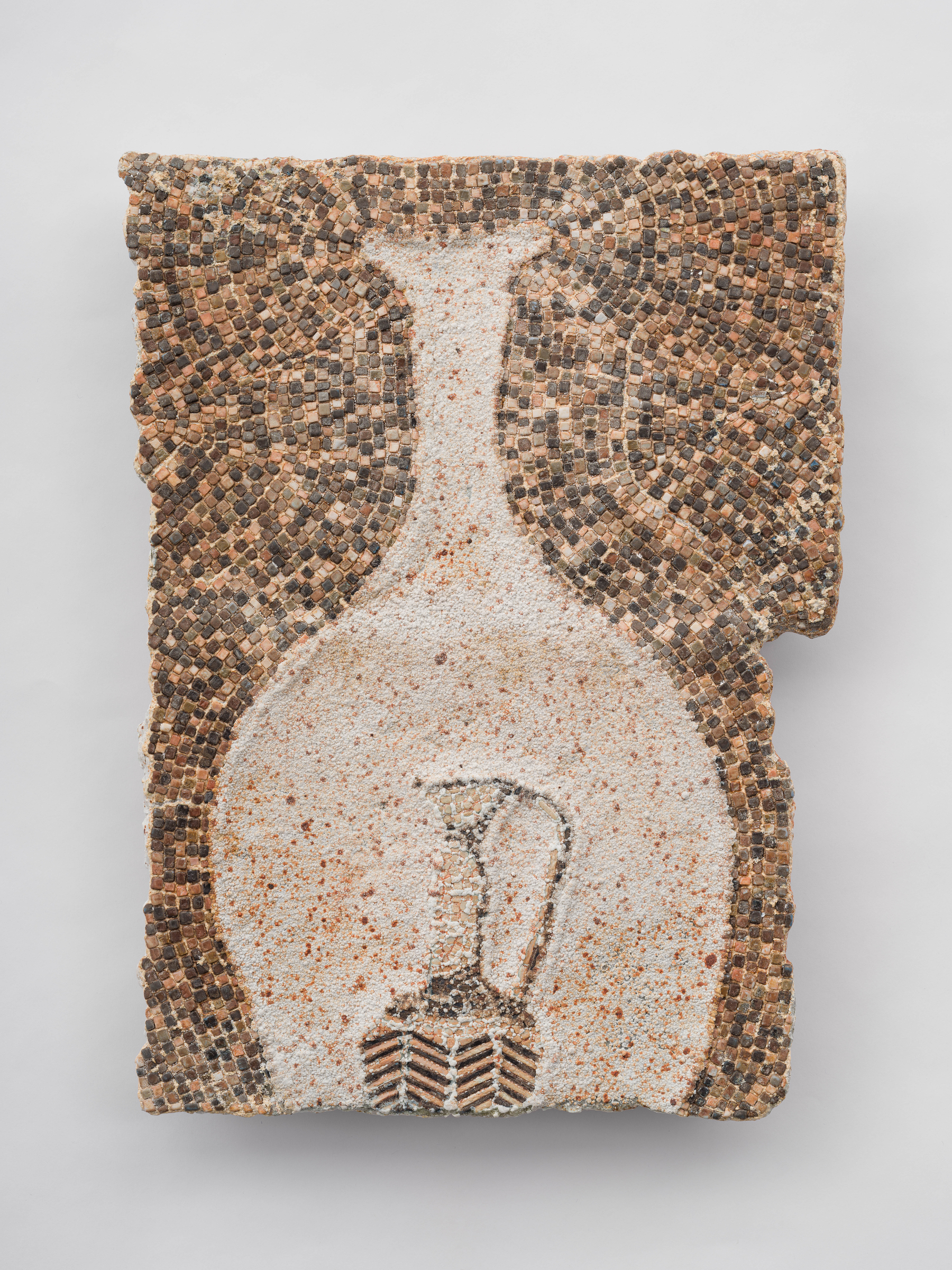For his first solo exhibition with Lisson Gallery in China, the Japanese sculptor Masaomi Yasunaga presents a new body of experimental and expressive vessel sculptures along with recently developed tablet works comprised of hand-made mosaic tiles forming intricate images. Renowned for his unprecedented production methods, Yasunaga’s work offers a re-evaluation of ceramic’s technical traditions and the vessel’s role in cultures across millennia, positing new expressive potential.
Inspired by cobblestone streets — which are shaped over time by countless footsteps — the exhibition centres around the notion of ‘stepping on the earth,’ conjuring a meditation on how human interaction and movement leave lasting traces and memories. Inspired by his upbringing within Japan’s Catholic minority and ensuing appreciation for aesthetics of Western origin, Yasunaga honours a global range of vessel forms and ritual objects. With titles referencing physical states of being — empty, melting, fused, molted, shedding, skeleton, flesh and bone — the artist evokes nature’s physicality and spirituality’s ascension into earthenware, eliciting an emotional connection with the viewer.
Yasunaga’s new Mosaic series is a nod to an artistic style of far-away places and long-ago times. The works extend Yasunaga’s exploration of multiple techniques, both ancient and cutting edge. Yasunaga’s pixelated tablets, which depict compositions of vessel containers in various arrangements, extend the vessel metaphors achieved by the raw and rough texture of his three-dimensional works.
Read moreTo enhance the more than thirty works displayed on walls and pedestals, the gallery floor is covered with an organic material that absorbs the footprints of visitors. As the audience moves through the space, the floor gradually accumulates footprints and marks, forming a shifting trail that alludes to the passage of time and to the impermanence of human presence. The presentation invites viewers to experience the depth of Yasunaga’s conceptual and material investigations and his unique approach to the intersection of time, body, and object.
Masaomi Yasunaga was a student of Satoru Hoshino, a protégé of the avant-garde ceramic group Sodeisha: a post-war (1940s – 1990s) movement that questioned the mandate of functionality within the ceramic medium and pioneered a new sculptural philosophy. The artists of Sodeisha, which translates as ‘crawling through the mud society’, rebelled against the prevalent ceramic traditions in Japan to create emotionally driven artworks. By focusing on the process of creation, centred around the sculptural form rather than the functional use of the object, Yasunaga extends the legacy of Sodeisha group’s experimental ethos and is faithful to the existential concerns of its founders.
A historic achievement of Masaomi Yasunaga’s practice is his unprecedented use of glaze, elevating ceramic’s surface treatment material to become his primary material. While pottery is typically formed from clay, fired in a kiln and sealed with a finishing coat of glaze, Yasunaga build his sculptural works with specially adapted glaze. Combined with unique raw materials such as feldspars, whole rocks, metal or glass powders, Yasunaga’s glaze forms are buried in various strata of sand or kaolin (unrefined porcelain clay) to preserve their structure in the firing stage. After cooling, Yasunaga’s sculptures are excavated from their beds in a studio process analogous to archaeological excavation and discovery. The yielded objects appear honed and shaped by earthly elements over centuries, some whole and others curiously fragmented. Aesthetically, these sculptures are simultaneously primitive and contemporary; objects of human culture which appear as if lost and found, seeming to confirm the supremacy of nature’s order over the world of mankind.
At the heart of Yasunaga’s practice is the elemental force of fire. In pursuit of ‘fundamental beauty’, the artist considers the flames as a filter and the kiln that controls the flame as a time machine. This represents Yasunaga’s intention to remove his will and ego, making room for a return to nature. Through meticulous manipulation of his singular glaze forms and firing techniques, Yasunaga transforms a decorative element into an expressive force that embodies both intention and unpredictability. The layered, organic surfaces of his works reflect the tension between control and chance, where the firing process reveals intricate textures and forms organically shaped by natural forces rather than artistic artifice. This distinctive approach to glaze sets Yasunaga apart from other ceramic artists, allowing for a nuanced exploration of materiality and temporality.
日本雕塑家安永正臣 (Masaomi Yasunaga) 在里森画廊的中国空间推出首次个展。此次展览呈现的作品包含一系列极具实验性与表现力的全新器皿雕塑,及由手工马赛克勾勒出精密图像的近期平板状系列。通过突破性的创作手法,安永正臣审视了陶器创作的技术传统,及器皿在数千年人类文化发展中的角色,并彰显这一媒介全新的表现潜力。
安永正臣师承星野晓 (Satoru Hoshino),后者是日本先锋陶瓷流派“走泥社”的成员之一。作为一场活跃于1940至1990年代的战后艺术运动,走泥社的宗旨是对陶瓷材料既定的功能产生质疑和反思,开创全新的雕塑哲学理念。走泥社的艺术家们挑战日本陶瓷传统,创作以情感为驱动的作品。安永的作品延续了走泥社大胆试验的精神,将精力集中在制作的过程,专注作品雕塑一般的外形轮廓,而非实用性及功能性。
安永正臣实践最大的特点在于他对釉料的运用方式:艺术家把这种常用于处理陶器表面的材料,作为其作品的主要媒介。陶器通常由黏土制成,经过窑烧后才会覆盖釉面,而安永却通过特殊改良的釉料来直接构筑雕塑作品。他结合了长石矿物、块状岩石、金属或玻璃粉末等独特原料,将以釉料做成的雕塑埋入沙土或高岭土 (未经精炼的瓷土) 中,以求在烧制过程中保持作品的结构。冷却后,作品就像考古发掘的文物般“出土”,作品形态有时完整有时破碎,仿佛经过了几个世纪的尘封与打磨。从美学角度而言,这些雕塑既原始又现代,仿佛是人类文明中失而复得的物品,证实着自然秩序凌驾于人类世界之上的真理。
本次展览的主题启发自由鹅卵石铺就的道路表面,它们往往由日积月累的行人脚步所塑造而成。围绕“踏足大地”的概念,安永意在通过展出的作品探讨人类的行为与活动如何留下持久的痕迹和记忆。为了强调本次展览的概念及更加突出展出的三十余件作品,展厅地面铺设了一种能够体现参观者足迹的地毯。随着观众在展览空间内移动,地面上的有机材料会逐渐累积脚印,形成一道持续变化的轨迹,暗喻时间流逝与人事无常。这一展陈方式引领观众体验安永的实践理念、对材料的探索,以及他处在时间、身体与物体之交汇点的独特创作手法。展览中的马赛克新作系列致敬了远古时代和遥远地域的艺术风格,并延续了艺术家对古老与前沿技艺的探索。这些平板状作品上的像素化图像,呈现出以不同方式排列的器皿,将多见于安永三维作品且质感原始粗粝的容器象征拓展到平面的维度中。
作为日本少数信仰天主教的教徒之一,安永一直深受西方艺术美学的影响,其实践也借鉴了全球各地的容器形态和仪式器具。其作品的标题援引了不同的状态,例如“空”、“融”、“熔”、“脱”、“蜕”、“骨架”和“骨肉”等,通过这些命名,艺术家从物质和精神层面为作品注入了大自然的形态和精髓,从而引发观众与作品间的情感联结。此外,火焰是安永创作的核心元素。在追求“本源之美”的过程中,艺术家将火焰视作滤网,而窑炉则是掌控火焰的时光机器。安永希望由此去除个人意志与自我,为回归自然腾出空间。通过对雕塑的精妙塑造及精湛的烧制技巧,安永将器皿的装饰性转化为表现力,既蕴含意念,也潜藏未知。其作品层次丰富的表面,反映了受控与随机之间的张力;烧制而成的复杂肌理与形态,是由自然力量有机塑造的,而非为艺术家的刻意设计。对于材料性和时间性的一系列细腻探索,都归因于安永对釉料独具一格的运用方式。




























